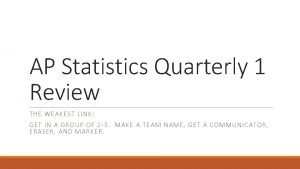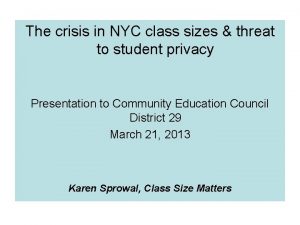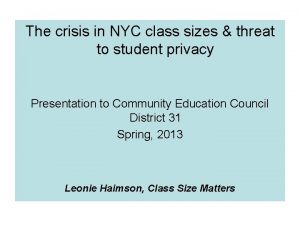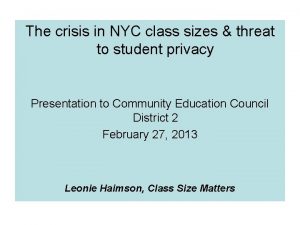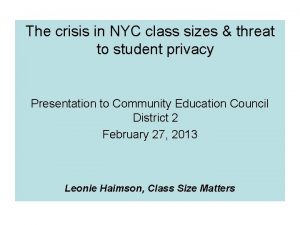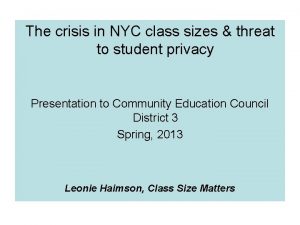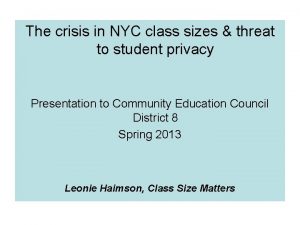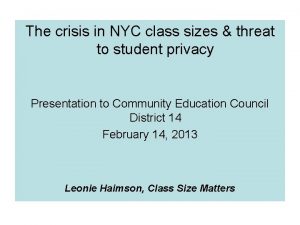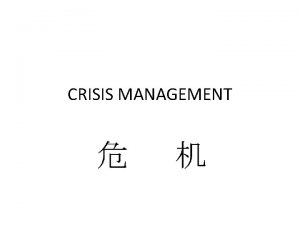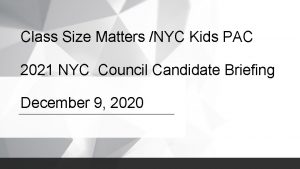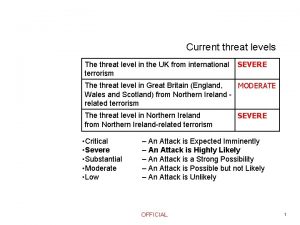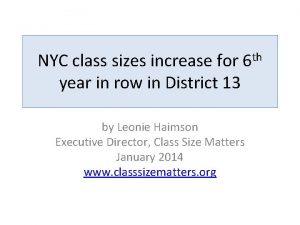The crisis in NYC class sizes threat to


















- Slides: 18

The crisis in NYC class sizes & threat to student privacy Presentation to Community Education Council District 30 February 21, 2013 Leonie Haimson, Class Size Matters

Why is class size important? • Class size reduction one of 4 reforms proven to work through rigorous evidence, acc. to Inst. Education Sciences, research arm of US Ed Dept. * • Benefits esp large for disadvantaged & minority students, very effective at narrowing the achievement gap. • NYC schools have largest class sizes in state; • 2003, NY’s highest court said students denied constitutional right to adequate education in part due to excessive class sizes (Campaign for Fiscal Equity decision). • 86% of NYC principals say cannot provide a quality education because of excessive class sizes. • Smaller classes top priority of parents on DOE learning environment surveys every year. • *Other three K-12 evidence-based reforms, are one-on-one tutoring by qualified tutors for at-risk readers in grades 1 -3, Life-Skills training for junior high students, and instruction for early readers in phonemic awareness and phonics.

Stagnant achievement in NYC schools under Bloomberg • NYC students have fallen further behind their peers in other large cities, according to national assessments (NAEPs), coming in 2 nd to last in progress since 2003; • NYC also only large district where non-poor students have lower NAEP average scores than in 2003. • Only 21% of NYC HS grads are considered “college ready”; 13 – 15% of Black and Hispanic students; • Students needing triple remediation* at CUNY have doubled in last 5 years. * Triple remediation means make-up classes in reading, writing & math.

Contracts for Excellence • In April 2007, NY State settled the Campaign for Fiscal decision by passing the Contracts for Excellence (C 4 E) law. • State agreed to send billions in additional aid to NYC & other high needs school districts; to spend in six approved areas, including class size reduction. * • In addition, NYC had to submit a plan to reduce class size in all grades. • In 2007, the state approved DOE’s plan to reduce class sizes on average to 20 students per class in K-3; 23 in grades 4 -8 and 25 in core HS classes. • In return, NYC has received more than $2. 5 billion in cumulative state C 4 E funds since 2007. *other allowed programs include Time on Task; Teacher & Principal Quality; Middle & HS Restructuring; Full-Day Pre-K; & Model Programs for English Language Learners

Class sizes have risen sharply in all grades since 2007…esp. in K-3; now largest in 14 yrs! D 30 K-3 average class sizes larger than citywide actual 26 25. 0 24. 4 C 4 E goals average class size 24 23. 2 22. 4 21. 9 22 citywide actual 21. 3 21. 8 21 20. 7 20. 5 20. 3 20 20. 1 19. 9 D 30 20 12 -1 3 2 20 11 -2 01 1 20 10 -2 01 0 09 -1 20 -9 20 08 -8 20 07 Ba se lin e 18 This year’s class size data is available at http: //schools. nyc. gov/About. Us/data/classsize. htm *All class size figures calculated averaging Gen. Ed, CTT and G&T November reporting.

What happened in D 30? Lost K-3 teachers/sections as population was growing K- 3 total gened students/sections over time 12400 12300 560 12, 330 550 12200 540 536 12100 12138 542 530 12074 12014 12000 520 11870 520 11900 510 11800 500 498 11738 494 11700 490 11500 470 11400 460 3 12 -1 20 20 11 -2 01 01 1 20 10 -2 -1 0 20 09 -9 20 08 2 480 -8 11600 20 07 student population 550 total students sections

In grades 4 -8, class sizes have also increased D 30 4 -8 average class sizes larger than citywide actual 28 27. 2 27. 6 27. 4 26. 6 26. 0 C 4 E target 26. 0 citywide actual 25. 6 24. 8 24. 6 24 D 30 23. 8 23. 3 22. 9 20 12 -1 3 2 20 11 -2 01 1 20 10 -2 01 -1 0 20 09 -9 20 08 -8 20 07 se lin e 22 Ba average class size 25. 7 26

Also in grades 4 -8, more students and fewer teachers/sections in D 30 than in 2007 4 th-8 th total students/sections over time 15200 560 15, 068 15000 555 14923 554 550 total students 545 sections 14624 14600 543 14252 14200 549 14454 546 14400 14222 541 540 538 14000 535 13800 -1 3 12 20 20 11 -2 01 1 20 10 -2 01 -1 0 20 09 -9 20 08 2 530 -8 13600 20 07 student population 14800

Also in HS: citywide average class sizes have risen High School Class Sizes vs CFE Goals (DOE High School data inconsistent and unreliable) 27. 5 27. 0 26. 6 26. 5 27. 0 26. 4 26. 3 26. 2 26. 1 26. 0 27. 0 26. 9 26. 8 26. 6 26 Nov. Class Sizes* 25. 7 25. 5 25. 2 C 4 E goals 25. 0 24. 8 24. 5 Feb. Class Sizes 24. 0 23. 5 -1 3 12 20 20 11 -1 2 -1 1 10 20 -1 0 09 20 -0 9 08 20 20 07 -0 8 23. 0 *There is no November reporting for the 2007 -08 year, data used is from Feb. report

Ways that DOE has worked AGAINST reducing class size • Since 2007, DOE has cut school budgets 14%– contradicting C 4 E prohibition against supplanting. • In 2010, DOE eliminated Early grade class size funding– despite promise in C 4 E plan to keep it. • In 2011, DOE decided no longer to cap class sizes in 1 st-3 rd grades at 28, leading to tripling of class sizes 30 or more in these grades. • In 2012, DOE instructed principals to accommodate special needs students up to contractual class size maximum. • DOE has never aligned either “Blue Book” formula or capital plan to goals in class size plan, as required by state law.

CFE funding also flat-lined; but even when increased; city’s class sizes grew! 700 29 $645 600 27 $531 25 400 24. 5 23. 9 300 $258 23 22. 9 22. 1 200 21. 4 21 21 20. 9 20. 7 100 20. 5 20. 3 20. 1 19. 9 $0 -1 3 12 20 20 11 -1 2 1 10 -1 20 20 09 -1 0 9 08 -0 20 07 -0 8 19 20 06 -0 7 0 Class Size Avgs. 500 20 dollars (in millions) $531 C 4 E spending (in millions) K-3 average class sizes C 4 E class size goals

Loss of teachers while DOE had other priorities • Number of pedagogues (mostly teachers) has been cut by more than 5, 000 since 2007, despite rising enrollment. * • Smallest # pedagogues in 2011 employed by DOE since 2003. • Largest # non-pedagogues in 2011 employed since at least 1980. • Highest % of non-pedagogues to pedagogues since 1993. • Spending on testing, contracts, consultants, and more bureaucrats have all risen sharply. (*Data source: Office of Management Budget headcounts, through IBO)

But can we afford to reduce class size? • In 2009, DOE estimated that it would cost $358 million per year to achieve average C 4 E class size goals across the city; • DOE estimated it would cost $448 million per year in staffing to achieve class size goals in ALL schools; plus more in capital costs for school construction. • This year, NYC received more than $530 million in C 4 E funds.

Other questions re city’s C 4 E plan • Why did the DOE not centrally devote ANY C 4 E funds to class size reduction, given its legal obligation to lower class size? • DOE finally posted C 4 E plan for this year only in Feb. , and holding hearings now, though funds mostly spent, making mockery of public feedback and process required in law. • Is DOE’s C 4 E plan for last year (2011 -12) yet approved by the state ? If so, where is it posted?

NYS & NYC also violating student privacy and parental rights • 9 states/districts including NYS sharing confidential student and teacher data with in. Bloom Inc. , private corporation funded by Gates Foundation. • Data includes student names, grades, test scores, disciplinary & attendance records, race /ethnicity, economic status, disability and health issues. • Data will be stored in a massive electronic data bank, built by Wireless Generation, run by Joel Klein & owned by Rupert Murdoch of News Corporation. • News. Corp found to illegally spy and/or violate privacy in UK and US.

Then what? • in. Bloom, Inc. plans to put this sensitive data on a cloud run by Amazon. com and transmit it to for-profit companies to help them develop and market their “learning products. ” • In recent survey, 86% of IT experts say they do not trust clouds to hold their organization’s sensitive data. • In its security policy, in. Bloom Inc. states they “cannot guarantee the security of the information stored in in. Bloom or that the information will not be intercepted when it is being transmitted. ’ • All this is happening without parental notification or consent.

Sample data to be shared with in. Bloom, Inc.

What can CEC’s do? • Pass resolutions on class size and privacy; we have samples for your consideration. • Write a letter to Commissioner King, to protest the botched C 4 E process & DOE’s failure to reduce class size at jking@mail. nysed. gov • Send comments to contractsforexcellence@schools. nyc. gov; deadline March 18. • Collect information about class sizes in your district’s schools, including violations of union contract & building code. • Parents should send opt out letter to King, demanding your child’s info NOT be shared; see our fact sheet for more info. • Questions or to join newsletter list, email us at info@classsizematters. org
 Men's shirt sizes are determined by their neck sizes
Men's shirt sizes are determined by their neck sizes Gravis grave
Gravis grave Hát kết hợp bộ gõ cơ thể
Hát kết hợp bộ gõ cơ thể Lp html
Lp html Bổ thể
Bổ thể Tỉ lệ cơ thể trẻ em
Tỉ lệ cơ thể trẻ em Voi kéo gỗ như thế nào
Voi kéo gỗ như thế nào Tư thế worm breton là gì
Tư thế worm breton là gì Chúa yêu trần thế
Chúa yêu trần thế Các môn thể thao bắt đầu bằng tiếng đua
Các môn thể thao bắt đầu bằng tiếng đua Thế nào là hệ số cao nhất
Thế nào là hệ số cao nhất Các châu lục và đại dương trên thế giới
Các châu lục và đại dương trên thế giới Cong thức tính động năng
Cong thức tính động năng Trời xanh đây là của chúng ta thể thơ
Trời xanh đây là của chúng ta thể thơ Cách giải mật thư tọa độ
Cách giải mật thư tọa độ Phép trừ bù
Phép trừ bù độ dài liên kết
độ dài liên kết Các châu lục và đại dương trên thế giới
Các châu lục và đại dương trên thế giới Thơ thất ngôn tứ tuyệt đường luật
Thơ thất ngôn tứ tuyệt đường luật
